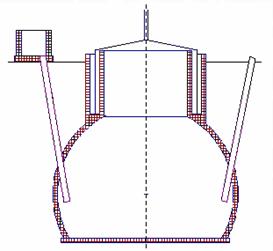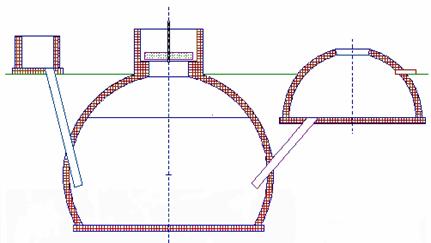· Biogas Energy Department.
· Wind and Solar Energy Department.
· Rural Energy Planning and Fuel Department.
·
Hydro-Power Department.
Research activities of Energy Institute in the field of Biogas Technology
· Design, construction, fabrication and test experiment of biogas plants and appliances
· Implement development projects in the whole country.
· Provide technical services for users.
· Provide training services for technicians and masons and transfer technology to other organizations.
·
Prepare technical
The main results of the development activities are as follows:
Number of plants installed in localities:
· Floating-gasholder made of steel sheet: 97
· Floating-gasholder made of ferro-cement: 50
· Fixed-dome built of brick: 186
Number of video tapes: 5, of which 4 video films have been diffused on Vietnam
Number of man
In collaboration with "Institut de I'Energie des pays ayant en commun
I'usage du francais (IEPF)" on preparation of the
man ual
"La filiÌre biogaz dans les pays en developpement".
Number of training courses: 7
Implementation of 3 projects supported by OXFAM, UNICEF and ACCT (Agence de cooperation culturelle et technique).
Design, construction, and test experiments of biogas plants
To
evolve low-cost designs suitable for
Floating gasholder plant (Figure 1).
This type of plant was mainly developed before 1984 with digester volume of 1 to 50 m3. Disadvantages are the cost of the plant needs to be brought down further, especially by replacing the steel gasholder.
Fixed - dome plant (Figure 2)
Since 1984 IE has concentrated on the design and development of a fixed dome digester with the spherical shaped wall built of brick. The first digester of this type was installed in 1987. More than 200 plants with the digester volume from 1 to 15 m3 have been constructed since 1988. This type was evaluated in 1990 and has replaced the floating gasholder one for popular extension. A computer program was compiled for calculating volumes, dimensions and drawing. The spherical structure is now applied for design of floating gasholder plants.

Figure 1:
Spherical shaped floating gasholder plant

Figure 2: Spherical shaped
fixed - dome plant
Application of biogas
Besides researching biogas for cooking and lighting, we are also interested in researching biogas as a clean fuel for other aspects. For example, biogas can be used for electricity generating, tea processing, fruit storing and hatching chickens. But some are still in process of trial, demonstration or further development. In this paper we only discuss two applications of biogas to generate electricity and for the storing of oranges.
Biogas in electricity generating
To use
biogas as a fuel for the international combustion engine, the engine must be
refitted. We have chosen to modify the smallest capacity of 4-stroke petrol
engine popular in the Vietnamese market named Shriram Honda EM650. It is simple
to refit the petrol engine: add a biogas-air mixer to the original carburettor,
and then biogas can be used to replace petrol to power the engine.
|
Table 1: Properties of
biogas-petrol engine Shriram Honda EM650 with real power of 50VA (Maximum
power of 550VA) |
|||
|
Parameters |
Unit |
Petrol |
Biogas |
|
Capacity |
|
|
|
|
At limited power regulation |
W |
143 - 550 |
220 - 360 |
|
At least fuel consumption level |
W |
400 |
360 |
|
Unit fuel consumption |
|
|
|
|
At limited regulation |
litres/kwh |
1.1 - 2.3 |
1300 - 1700 |
|
At least fuel consumption level |
litres/kwh |
1.1 |
1300 |
|
|
litres/hour |
0.44 |
468 |
The experience shows that to generate
electricity with biogas produces good economical results as 1m3 of
biogas can replace 0.85 litres of petrol. A generator of 450 VA requires 3 m3
of biogas for 5 hours each evening. The biogas plant must have a minimum
digester volume of 10 m3 (30 pigs with weight of about 50 kg/head or
15 cattle). The electricity power is sufficient for 3 electric bulbs of 100W
(or 7 fluorescent lights of 40W) and 2 electric appliances like television or
radio sets of 75W.
Biogas in orange storing
Use
of biogas to store oranges has the advantages of being simple, economical,
effective and without toxicity poisoning. This method has been sucessful in
Conclusion
The
experience gained from the multi-use and social response to biogas technology
reveals it to be appropriate for wide scale application in rural areas in
In
addition, in urban areas, anaerobic technology can be also applied to treat
industrial wastes and waste waters. It not only saves energy but also produces
more energy during wastewater and solid waste treatment processes. The tropical
climate is a very suitable condition for anaerobic fermentation. Consequently,
this technology should be disseminated for meeting the de
· Integration of biogas programs at all levels of policies and planning processes.
· Local, regional and national budgets have to provide allocations mainly for promotion, training, building and improvement of necessary infrastructure, R&D and implementation programs.
· Initially, adequate incentives and regulatory measures in tax-structures and other laws must be provided to bring biogas programs to equal terms with competing technology systems. This will also encourage NGO¢s and private entrepreneurs.